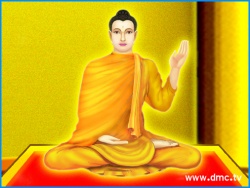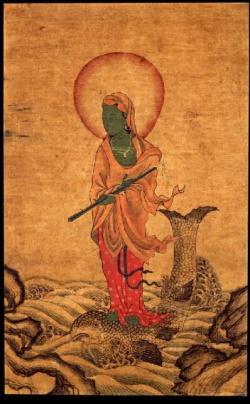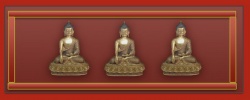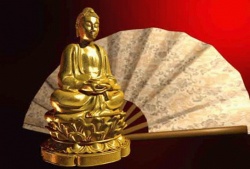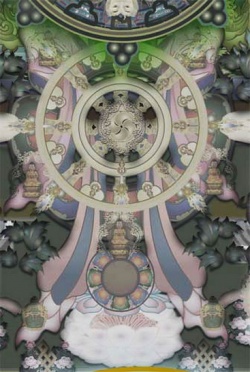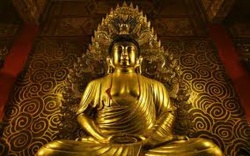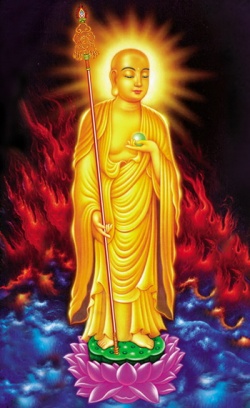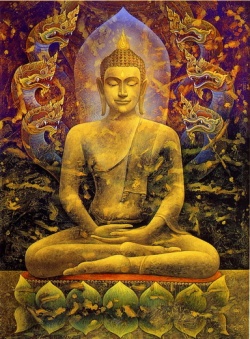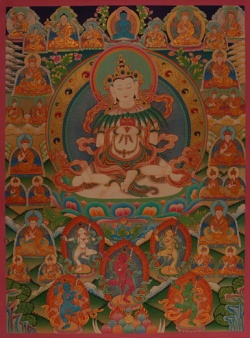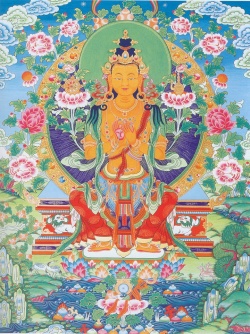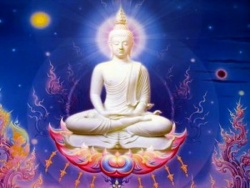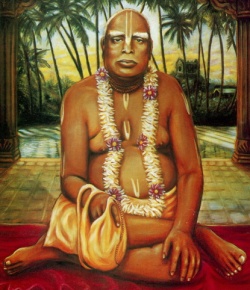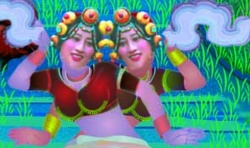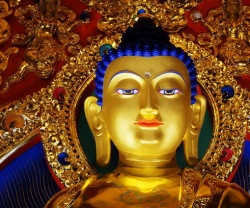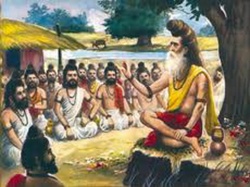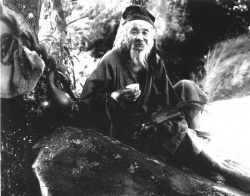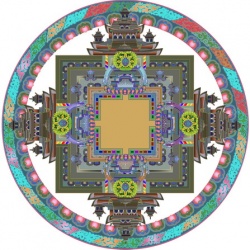The Rinchen Terdzö is a collection of,,,(1)
'
THE GREAT RIVER OF BLESSINGS
WALKER BLAINE
Dedicated to The Lineage of Sakyongs and the Kingdom of Shambhala
Rinchen Terdzö that was conferred by His Eminence Tertön Namkha Drimed Rinpoche on the Kongma Sakyong Mipham Rinpoche between December 5th, 2008 and March 6th, 2009. The Rinchen Terdzö is a collection of hundreds of empowerments and teachings that bring together the essential terma lineages of the Nyingma, the earliest school of Tibetan Buddhism. The empowerments of the Rinchen Terdzö
occurred at Rigön Thupten Mindroling, His Eminence’s monastery in the hot, isolated hills of Orissa, an hour and a half’s drive from the east coast of India. Sakyong Mipham Rinpoche asked me to attend the Rinchen Terdzö in order to write a blog about the event.
A newly edited version of the blog forms the basis of this book. The Sakyong wanted a daily report posted from India so that the Western sangha could learn what it was like for him to study and practice in Asia. The empowerments carried a special significance for Sakyong Mipham Rinpoche: Namkha Drimed Rinpoche had received the Rinchen Terdzö directly from the Sakyong’s father,
the Vidyadhara Chögyam Trungpa Rinpoche. Receiving the Rinchen Terdzö meant that the Sakyong would carry the Vidyadhara’s transmission lineage of the main practices in the Nyingma tradition. This book is also the companion volume to The Golden Mirror of
Wisdom: Images of the Rinchen Terdzö in Orissa, India. At the end of the Rinchen Terdzö, Sakyong Mipham Rinpoche suggested we create a coffee table book about the Rinchen Terdzö. More than 100 photographs were selected from the thousands of pictures taken at the event. These were assembled into a large, hardcover volume.
There is a long list of thanks at the end of the book, but I would like to take this opportunity to express my deep gratitude to His Eminence Namkha Drimed Rinpoche for bestowing the Rinchen Terdzö on Sakyong Mipham Rinpoche and, in a sense, on the entire Shambhala community. I am also profoundly grateful to Sakyong Mipham Rinpoche for asking me to go to India and write about the
empowerments. Personally speaking, attending the Rinchen Terdzö was one of the most extraordinary experiences of my life. While in India, I found myself increasingly happy for Shambhala and the world because the teachings of the Rinchen Terdzö were being carried forward to the next generation.
Through His Eminence Namkha Drimed Rinpoche’s presence, I saw the living wisdom behind the words of the empowerments. Through his kindness and exertion, I had glimpses of the great potential that lies within us all. May all beings be quickly liberated from the sufferings of samsara and realize the dawn of the new golden age, the Kingdom of Shambhala, and the Great Eastern Sun. Walker Blaine
The Rinchen Terdzö, known in English as The Precious Treasury of Termas, is a collection of nearly 900 empowerments for meditation practices based on termas, treasure teachings that were concealed by one great master to be discovered at a later time (and sometimes
place) by another great teacher when such teachings would be the most beneficial. The Shambhala termas discovered by the Vidyadhara Chögyam Trungpa Rinpoche are in this category of teaching.
The Rinchen Terdzö was assembled by the 19th century teacher Jamgön Kongtrül Lodrö Thaye (1813-1900). The collection is 111 volumes in its modern printing, with the average volume being between 500 and 600 pages long. The Rinchen Terdzö took 33 years to compile and is made
up of the most historically important and vital termas discovered between the 11th and 19th centuries. Many of these termas remain popular even in the present day and are practiced by Asians and Westerners alike. An empowerment (Skt. abhisheka, Tib. wang) is a
ritual display of all aspects of the path to complete enlightenment from the perspective of a single style of vajrayana practice. Within the vajrayana there is a huge number and a great variety of abhishekas; it is very difficult to see how everything fits together.
Jamgön Kongtrül Lodrö Thaye masterfully organized the Rinchen Terdzö into a rich and detailed sequence that presents the full range of practices used in the Nyingma tradition, the oldest of the four major contemporary schools of Tibetan Buddhism. The Rinchen Terdzö itself, along with the each of the individual practice within it, is a major teaching on the path of practice and realization. Receiving
the Rinchen Terdzö is a three-month experiential journey that starts at the entrance of the vajrayana path and moves through increasingly profound and subtle presentations of complete enlightenment. Along the way, the practitioner is led through all aspects of how to generate and stabilize the mind of wisdom.
The journey is multilayered and presents the contemplative journey from a wide variety of entry points. It is like a compass or map marked with meditation techniques arranged according to the development and inclinations of the practitioner. On paper it is not easy
to convey that the Rinchen Terdzö is a living transmission. The Sakyong remarked that in his 22 years of studies and retreats Asia he had never encountered such a wonderful situation for practice.
Until starting research a few months before my arrival in Orissa, most of what I knew about the Rinchen Terdzö came from Born In Tibet, Chögyam Trungpa Rinpoche’s account of his life in Tibet and escape to India. Descriptions of the Rinchen Terdzö take up many pages in the chapters dedicated to the Vidyadhara’s education and early adulthood. Along with being eager to learn more about the mind
and training of the Vidyadhara, I was excited to go to India to experience the Rinchen Terdzö myself and understand its importance to Sakyong Mipham Rinpoche and Shambhala.
The Rinchen Terdzö represents a major jewel that the Sakyong and Shambhala inherited from Chögyam Trungpa Rinpoche. The Vidyadhara said the collection contained all the wisdom held by his predecessor, the 10th Trungpa. The practices presented in the [[Rinchen
Terdzö]], both historically and in their sequence as an intricate presentation of the path, represent the heart of the Nyingma tradition and in some ways, the heart of the vajrayana.
All schools of Tibetan Buddhism, as well as Tibet’s indigenous Bön religion, have important teachings in the collection. With respect to the Shambhala terma discovered nearly a century after Jamgön Kongtrül had compiled the Rinchen Terdzö, the collection is a presentation of the central lineage tradition from which the Shambhala teachings have sprung.
The Vidyadhara received the Rinchen Terdzö from his teacher, Jamgön Kongtrül of Shechen, a rebirth of Jamgön Kongtrül Lodrö Thaye. Shechen Kongtrül received the lineage from Shechen Gyaltsap, who received it from Jamgön Kongtrül Lodrö Thaye himself. There are varied accounts of how the lineage passed from Jamgön Kongtrül Lodrö Thaye to Chögyam Trungpa Rinpoche. In this book I relied
on Chögyam Trungpa Rinpoche’s description in Born In Tibet, Sakyong Mipham Rinpoche’s remarks about conversations with his father, and statements made by Namkha Drimed Rinpoche’s son, Jigme Rinpoche about the lineage of the Rinchen Terdzö. Chögyam Trungpa Rinpoche bestowed the Rinchen Terdzö for the second and final time in 1958 at Yak Gompa in eastern Tibet.
It was his last formal teaching before he started his escape to India. During the concluding ceremonies of the Rinchen Terdzö, the Vidyadhara empowered His Eminence Namkha Drimed Rinpoche as the primary teacher responsible for carrying on his transmission of the Rinchen Terdzö tradition. His Eminence is the only remaining holder of Chögyam Trungpa Rinpoche’s lineage of this precious
collection of teachings. It is both wondrous and fortunate that His Eminence was able to bestow the empowerments on Sakyong Mipham Rinpoche, the Vidyadhara’s son and lineage heir. His Eminence Namkha Drimed Rinpoche is an extraordinary individual. He is the supreme head of the Ripa lineage, which was established as a family line by Ripa Pema Deje Rolpa in the early 19th century.
The Ripa lineage has its roots in the termas of Taksham Nuden Dorje (b. 1655), whose practices Namkha Drimed Rinpoche also upholds. Many of the great masters of Tibet and especially of the Nyingma have praised His Eminence’s realization and activity, and the Tibetan community holds him in high esteem for his kindness, wisdom, and the power of his practices for healing,
divination, and the pacification of obstacles. His Eminence, like the Vidyadhara, is a tertön and he has revealed more than eight volumes of terma teachings. His most well-known terma revelations include many practices of the warrior-king Gesar of Ling, one of the ancestral sovereigns of the Shambhala tradition.
That the Rinchen Terdzö empowerments in Orissa, India and at Yak Gompa in Tibet were bestowed by living tertöns is remarkable. It is not always the case that the recipients of the empowerments have had such good fortune. These circumstances added to the
profundity of the ceremonies in India, and pointed toward other important connections between the Chögyam Trungpa Rinpoche and Namkha Drimed Rinpoche.
For example, the Vidyadhara and His Eminence shared visions of Akar Werma, the deity whom the Vidyadhara called Shiwa Ökar. Shiwa Ökar is an important figure in Chögyam Trungpa Rinpoche’s Shambhala termas and in the New Treasures termas discovered by His Eminence. Another connection between Namkha Drimed Rinpoche and Chögyam Trungpa Rinpoche has to do their personal and cultural relationship with Gesar of Ling, the legendary warrior king who revived the vision of an enlightened kingdom in eastern Tibet during the tenth century.
Gesar’s influence on the Tibetan culture and practice was tremendous. Generally speaking, the tertöns from eastern Tibet often trace their former lives both to the time of Padmasambhava and to the court of Gesar of Ling. For example, His Holiness Dilgo Khyentse Rinpoche discovered a Gesar terma while visiting Chögyam Trungpa Rinpoche’s monastery, Surmang Dütsi Til, when the Vidyadhara was young. The bardic tradition of telling Gesar stories and the terma tradition of Gesar practices continues to this day.
Gesar was cited by the Vidyadhara as one of the sources of the Shambhala teachings, and Gesar is also the most prominent of the ancestral sovereigns mentioned in the Shambhala termas.
Namkha Drimed Rinpoche has discovered a vast quantity of Gesar terma practices, far more than any other tertön. The
Vidyadhara knew of His Eminence’s relationship with Gesar and wrote a Gesar practice especially for him. On the occasion of their second meeting, at Pema Kö during their escape from Tibet, the Vidyadhara knew of His Eminence’s arrival a day ahead of time through a vision of Gesar arriving with his retinue of warriors.
The recently completed main shrine room in the new monastery complex at Rigön Thupten Mindroling was the site for the Rinchen Terdzö. The main shrine room was incredibly colorful and bright, with newly painted sculptures and frescos of hundreds of teachers, deities, and offerings. The monastery complex is part of five camps, villages that are home to a small, but thriving Tibetan community that grew from the refugees who settled in Orissa with Namkha Drimed Rinpoche in 1966.
The land around the camps is beautiful and rough. In the wintertime, the unirrigated fields used to raise corn after the summer monsoons are hard and dry. We saw no rain and hardly a cloud during the 95 days we spent in Orissa. Most of us were drinking four or more liters of water a day. The sun was so bright that by midday it was often overwhelming to stand outside for more than ten or twenty minutes at a time. Fortunately, the huge and airy H. E. Namkha Drimed Rinpoche main shrine room remained pleasant and comfortable throughout the
empowerments. The lack of rain made the threat of malaria low. Despite the heat we were told that it was cooler than usual during the Rinchen Terdzö. The three months of gentle conditions were said to be a sign that the local deities were happy about the events at the monastery.
The Sponsors Sakyong Mipham Rinpoche, the Sakyong Wangmo, and the Shambhala community were the primary sponsors of the Rinchen Terdzö. It was a huge effort for the monastery and the local community to host such a gathering. The inhabitants of the region, Tibetans and Indians, had never before witnessed anything on the scale of the Rinchen Terdzö. On many occasions [[Namkha Drimed
Rinpoche]] stressed how important the ceremonies were for the well being of the region. Orissa is a major tantric site in India as well as being the region where the Buddha taught Kalachakra the tantra to King Dawa Sangpo, the first
dharmaraja of Shambhala. Orissa had not been home to such lengthy, elaborate Buddhist practice for many centuries. This was due to Buddhism’s almost total absence in India from the thirteenth century until the 1950s.
The Rinchen Terdzö was like a cool breeze blowing the life-breath of tantra to Orissa’s land and inhabitants. The Schedule The schedule for participants at the Rinchen Terdzö was quite intense. During the three months of the event, apart from the three days of the Tibetan New Year, we had four days off. The events started at six-thirty in the morning when His Eminence’s son, Dungse Lhunpo Dechen Gyurme Rinpoche, also known
as Lhunpo Rinpoche and Lhuntrul Rinpoche, began the reading transmission. The reading transmission (Skt. agama, Tib. lung) was a reading of everything not spoken aloud during the empowerments.
The lung continued until noon each morning with a one-hour break for breakfast. After lunch, at one o’clock sharp, the empowerments began with the sound of gyalings, shrill Tibetan horns, heralding His Eminence’s immanent arrival in the shrine room. The gyalings were the last minute warning for the rest of us to get to the main temple. The empowerments then ran for six or seven hours with a short tea served in the
shrine room in the middle of the afternoon, and a brief bathroom break sometime later. The tea lasted ten or fifteen minutes at the most. Often we’d finish receiving the empowerments (sometimes fifteen in a day) at seven or eight o’clock in the evening.
It was inspiring to see how a large monastery with hundreds of lay guests could run like clockwork. This was possible because of the atmosphere of devotion around His Eminence’s incredible discipline. His Eminence had the most demanding schedule of all. He rose at four in the morning to do his personal meditation before he started specific practice preparations for the empowerments at six-thirty.
The Recipients The foremost recipient of the Rinchen Terdzö was Sakyong Mipham Rinpoche. Both he and Lhunpo Rinpoche were enthroned as holders of the lineage at the end of the event. Three others received the empowerments directly from His Eminence during the ceremonies: his son Jigme Rinpoche (who had been empowered as a lineage holder by His Eminence ten years ago in Tibet),
His Eminence’s nephew Tulku Kunchab Rinpoche, and the Sakyong Wangmo Dechen Choying Sangmo, the youngest daughter of His Eminence and wife of Sakyong Mipham Rinpoche. The second tier of the recipients of the empowerments was made up of the rest of the Ripa family along
with the khenpos, lamas, and honored guests at the event, such as the representatives of His Holiness the Dalai Lama. This group received the empowerment articles and substances (like water from ritual vases) from the five main recipients, who had already received the empowerment from His Eminence just a few moments earlier.
At the of each day, His Eminence, the Sakyong, and the other rinpoches, khenpos, lamas, and chöpöns (the shrine master and assistants) would take the day’s empowerment items out to the rest of the assembly to formally confirm the abhishekas on the rest of us. Often
the day would close with a short feast offering before closing chants. The feast food sometimes included unusual treats like bubblegum, chokingly spiced deep fried pretzels, and tiny tubs of colorful sugared gelatin.
Seeing the empowerments bestowed in the context of the Ripa family lineage provided another context to understand the family lineage that Chögyam Trungpa Rinpoche established at the center of the Shambhala tradition in the West. It was edifying to see that the
wife and daughters of His Eminence were given the same honor and respect as the lamas and khenpos in the community. I have rarely seen feminine principle so universally respected in a male monastic environment. I recall how refreshing it was to see Tulku Kunchab Rinpoche hug his cousin, one of the Sakyong Wangmo’s sisters, one morning on the monastery steps.
The moment of affection happened amidst a sea of young monks thundering down the stairs to get The Kongma Sakyong Mipham Rinpoche to their breakfast. After closing chants each day, the daughters of His Eminence often stayed in the shrine room chatting and warmly nurturing the littlest of the monks, some of who were as young as four or five. Altogether, about eight hundred people attended the entire
Rinchen Terdzö. Of these, about 400 were monastics (a few of whom were nuns) and about 400 were Asian and Western lay practitioners. Almost everyone was a student of His Eminence, Jigme Rinpoche, Sakyong Mipham Rinpoche, or Chögyam Trungpa Rinpoche.
Roughly 200 additional people attended the opening days of the Rinchen Terdzö and the total number of participants swelled to 1,400 during the final week of the event. 3,000 attended the concluding ceremonies. There were guests from India, Nepal, Bhutan, Japan, and all over Europe, as well as from North and South America. Not including the Sakyong and Sakyong Wangmo, five of the
12 long-term Shambhala participants came from Nova Scotia. Most of the Tibetan sangha in attendance were from the different camps, although some Tibetans came to Orissa from north and south India, Nepal, and Bhutan. The Tibetans at the empowerments ranged in age from newborn to great-grandparents in the community.
It was wonderful to see that a large number of children, teenagers, and twenty-year olds were among the lay recipients of the Rinchen Terdzö. The Teachers And Their Gifts One of the major gifts we received during the Rinchen Terdzö was a glimpse of the intensity of the practice tradition that existed in Tibet at the time of Chögyam Trungpa Rinpoche. Seeing His Eminence on the throne from dawn till
dark for three months gave a picture of the dedication and training that flourished in previous centuries. It also gave us a much better sense of what made the Vidyadhara who he was. One reason that the Sakyong wanted this transmission was to gather into himself more of the training that made his father such an incredible teacher.
By the end of the empowerments I found myself thinking how little we have understood about the strength, courage, and determination of teachers of the past. In this era of air travel, perfect sound systems, and video recording we have had
incredible treasures handed to us, but we often don’t stop to consider what it takes to become a genuine holder of the teachings. I felt humbled and proud that the Sakyong does know what it takes to carry the teachings forward, and that he is doing his very best to prepare to pass the
teachings on to the future Sakyong, to Shambhala, and to the rest of the world. His Eminence Namkha Drimed Rinpoche is a brilliant and subtle teacher. I began attending his teachings in the West because he is an important figure in the lives of both the Sakyong and the Vidyadhara.
It was not until the Rinchen Terdzö that I understood the depth of His Eminence’s immersion in the lineage of formal practice and realization. When His Eminence is not practicing, he is either reading or writing texts. I think he is very special in this regard. He reminds me of the great masters of the past who were one-pointed in their dedication to preserving the transmission
lineage of the teachings. As the days of the empowerments progressed and we settled into the rhythm of receiving the Rinchen Terdzö, I found Namkha Drimed Rinpoche’s presence increasingly compelling. I began to pay more attention to the traditional advice about doing one’s best to open up to the teacher as much as possible. It was an incredible opportunity to witness his discipline, devotion,
and kindness for weeks on end. Occasionally His Eminence burst into a broad smile or fatherly chuckle from his seat. This would sometimes happen when members of his family started bumping into one another under his throne during a rapid series of empowerments. His Eminence is a truly remarkable teacher and a genuinely humble person.
When the empowerments concluded and it was time to say goodbye, there was no adequate way to express how amazing it was to have spent so much time with him. Throughout the Rinchen Terdzö I was able to meet with Sakyong Mipham Rinpoche and Jigme Rinpoche to ask questions and get advice about what to present in the blog. Many, if not all, of the insights and interesting ideas in this document came from
them or from the various books I used for research. A particularly useful discussion came when I asked Jigme Rinpoche why so few of the empowerment rituals in the Rinchen Terdzö were written by the tertöns who originally discovered the termas. This question was important to me because the Vidyadhara did not write the empowerments for his two most well known sadhanas (liturgical practices), the
Sadhana Of Mahamudra and The Roar Of The Werma, more commonly referred to as the Werma Sadhana. Jigme Rinpoche explained that in many cases tertöns do not use empowerment rituals because they are so close to the source of the transmission of the terma.
This made me think about how Chögyam Trungpa Rinpoche presented the Shambhala teachings, his emphasis on creating an uplifted environment, and how powerful it was to be around him. Jigme Rinpoche went on to explain that an empowerment ritual is necessary
because a tertön’s successor has a different mind than the tertön. The transmission must be presented in a formal way so that the lineage can be passed on properly. Learning this helped me understand why the Sakyong had to write an empowerment for the Werma Sadhana, and why His Holiness Dilgo Khyentse Rinpoche wrote an empowerment for the Sadhana Of Mahamudra.
These two traditions are now preserved for future generations, much like the traditions that have been preserved in the Rinchen Terdzö. During a final meeting, the Sakyong said it would be impossible to tell anyone what happened during the Rinchen Terdzö. As I write this I have to laugh because I spent three and a half months in India trying every day to tell people what happened. It was an
extraordinary event, and it is my aspiration that the Rinchen Terdzö will be offered many times in the West, starting in the not-too-distant future. After spending a few days in Orissa and wondering whether I would be bored during the seemingly endless weeks
of empowerments, I noticed that the environment was not that different from a dathün or sesshin. All one had to do was open up, relax, and be curious. As both the Sakyong and Jigme Rinpoche said at different times in Orissa, “Who wouldn’t want to do this?”
Terma teachings are hidden so that they can be revealed in a future time and context when they will be needed most, when beings will be most capable of using them. Strictly speaking, they are a unique feature of the Tibetan tradition, and in particular of the
Nyingma lineage. Terma practices tend to be pithy, effective, and easier to use than their counterpart, the teachings of the kama. Ka means command or word in the honorific sense and implies the original spoken teachings of the Buddha.
The kama are the earliest teachings that came to Tibet from India and have been handed down orally since that time. While the kama practices are still preserved at some monasteries, they are lengthy and complex. Most of the Nyingma practices being done today are based on termas. Termas are a timely and energetic means to present the dharma and achieve realization. The Rinchen Terdzö is
transmitted by means of two principal methods, the empowerment and the reading transmission. The sequence of empowerments and reading transmissions in the Rinchen Terdzö presents a systematic journey through mahayoga, anuyoga, and atiyoga, which are the three uppermost divisions of the vajrayana path in the context of Nyingma practice.
In its most expanded form, the Rinchen Terdzö contains around 900 empowerments and represents the lineages of well over a hundred tertöns and visionaries. Whether a realized lineage holder or an ordinary practitioner receives the Rinchen Terdzö, the vajrayana teachings and practices presented in the collection are invaluable. In most cases, different teachers perform the empowerment and reading
transmission of the Rinchen Terdzö. The reading transmission includes the ‘small letters’ or notes for the practices, the instructional manuals, the life stories the tertöns and visionaries who discovered the termas, and the life stories of Padmasambhava. While not essential for personal practice, the reading transmission is necessary for those who are responsible for bringing the complete
transmission to future generations. More than half the Rinchen Terdzö is read aloud during the lung. The rest is read during the empowerments. There are two types of recipients for the Rinchen Terdzö. The first type is someone given the responsibility, at least
potentially, of carrying the transmission of the Rinchen Terdzö forward and bestowing it on the next generation of teachers. At any
Rinchen Terdzö empowerment, one or more of this type of recipient is enthroned as a lineage holder and given the direct responsibility to carry the transmission forward.
The second type of recipient is the general practitioner, someone who receives the practices of the Rinchen Terdzö, but not the responsibility to carry the lineage forward. Some people in this group intend to practice at least some of the traditions in the
collection; others receive the Rinchen Terdzö purely as a blessing without any intention to do the practices. For all recipients, the teachings and practices of the Rinchen Terdzö are planted as seeds to be ripened later, either in this or a future life. In a way, this is the main blessing of any empowerment—one is receiving the seeds of wisdom. These seeds are meant to help ripen us as genuine
practitioners. The Origin And Lineage Of Termas Sometimes we say that a tertön, or treasure revealer, is the source of a terma, meaning that he or she was the accomplished teacher who found a terma that had been hidden by the Padmasambhava or another realized being. We can also say, for example, that Padmasambhava was the source of a terma, meaning that he created a terma that a tertön found later on.
The termas were in turn based on what Padmasambhava and his contemporaries had received from his own teachers in several different lineages that eventually trace themselves back to non-human, transcendent origins. Vajrasattva, who is seen as the embodiment of all the buddhas, and the bodhisattva Vajrapani are transcendent beings that taught the three tantric vehicles of
mahayoga, anuyoga, and atiyoga to fully realized human beings like Garab Dorje, the first human holder of the atiyoga lineage.
The lineage traces itself back even further, from Vajrasattva and Vajrapani to the most primordial expression of enlightenment, Samantabhadra Buddha, who is also the embodiment of our own fully realized buddha nature. If we look at the journey of the
teachings coming from Samantabhadra to the tertön, it can be divided into three major sections. It starts with The Mind Lineage Of The Victorious Ones, which is the transmission of the teachings from Samantabhadra to an already enlightened retinue of buddhas.
Next comes The Symbolic Lineage Of The Vidyadharas, which is the transmission of the teachings from transcendent beings like Vajrasattva to fully realized human beings like Garab Dorje and other highly realized figures early in the lineage.
Finally, there is The Oral Lineage Of Ordinary Beings, which starts from Padmasambhava and his contemporaries, Vimalamitra and the translator Vairocana, and continues down to our own teachers in the present day. These three stages are called The Three
Lineages, and they are used to trace the origins of the Nyingma inner tantras, and particularly the dzogchen teachings. Chögyam Trungpa Rinpoche, in his book Crazy Wisdom, shows how The Three Lineages relate to the personal relationship that we might have with our own teacher. The oral lineage refers to how we begin to experience the truth of the teachings through words and techniques.
The symbolic lineage refers to the relative level of what Trungpa Rinpoche called ‘crazy wisdom’, how the teacher can without effort create incidents and environmental chaos that communicate the meaning or experience of awakening in the
student’s life and mind. The mind lineage refers to an atmosphere of mutual understanding, where the meaning of the dharma is understood nakedly without language, symbolism, or incident.
The idea to conceal the termas arose in the 8th century when Padmasambhava made many specific predictions about the eventual decline of the teachings in Tibet. King Trisong Detsen and others asked what could be done, and Padmasambhava replied that the
only thing to do was to preserve the teachings and sacred objects for people to recover later on, when human dignity and understanding were weakening. In that way, the tradition could be revitalized; the teachings could remain fresh by making an immediate and intimate connection to Padmasambhava and other masters through the direct link of a tertön’s mindstream.
Padmasambhava hid most of the termas with the help of Yeshe Tsogyal, who was his main disciple and Tibetan consort. The Rinchen Terdzö also contains termas from the Indian master Vimalamitra, and the great translator, Vairocana. They were
contemporaries of Padmasambhava and key figures in firmly establishing the Buddhist teachings in Tibet. The termas were hidden in the minds of realized disciples, in space, and in worldly places like rocks, earth, trees, and buildings.
When the rebirths of the realized disciples of Padmasambhava, Vairocana, and Vimalamitra discovered the termas in later centuries, it was accomplished through the interdependence of three things: the terma (or its location, in the case of a physical
object) being hidden by Padmasambhava in the tertön’s wisdom mind, Padmasambhava’s powerful aspiration-prophecy that the terma be recovered by the tertön in the future, and the help of the deities who promised to protect the termas. Padmasambhava
Some of the texts in the Rinchen Terdzö are re-discovered termas or yangter. Yangter are termas that were found, re-hidden, and discovered anew by an even later tertön. This might happen if the conditions were not right for a particular terma to be shared at the time of its
discovery. Other texts in the collection are pure visions (Tib. dagnang), teachings given directly by a deity, such as Tara, to a human disciple. A pure vision is different from a terma, which is a teaching hidden by a realized teacher in an earlier
era to be discovered later. There is even one practice that is neither a terma nor a pure vision, the fasting practice of Nyung Nay, which Jamgön Kongtrül felt was important enough to be included in the Rinchen Terdzö.
Three tertöns seem particularly important in the context of the Rinchen Terdzö because of their efforts to preserve terma lineages for future generations. The first is Minling Terchen, also known as Terdak Lingpa, who compiled The Wish-Fulfilling Vase, a 17th century collection of essential termas that became one of the seeds of the Rinchen Terdzö. The second important figure is [[Jamyang
Khyentse Wangpo]], who had the initial inspiration for the Rinchen Terdzö, and was able to pass on a large number of terma lineages, both his own and those of other tertöns, to Jamgön Kongtrül Lodrö Thaye. Finally, there is Jamgön Kongtrül Lodrö Thaye himself, whose
efforts to preserve the terma teachings are almost unimaginable. It is impossible to know the complete intention of Jamgön Kongtrül Lodrö Thaye when he decided to create the Rinchen Terdzö.
Because of Padmasambhava’s prophecies that the dharma would suffer a great setback in Tibet during the 20th century, it is conceivable that the five major collections of texts gathered by Jamgön Kongtrül (the Rinchen Terdzö being just one of these) were created in part so that the teachings would not be lost during the difficult times that continue to threaten the continuity of the teachings in our
era. Whatever the reason, the Rinchen Terdzö provides a major link to many extraordinary practice traditions that strengthened not only the Nyingma, but all lineages from the 11th century onward. It is a great wonder that the transmission continues.
It is said that only one complete copy of the final edited version of the Rinchen Terdzö made it out of Tibet during the Cultural Revolution. There is nothing else like it in the Buddhist world. Coming Forward Into Our Time Chögyam Trungpa Rinpoche became a lineage holder of the Rinchen Terdzö when he was twelve years old. It was not unusual for a young lama to be given such a huge
responsibility, particularly a lama like the Vidyadhara, who was a tülku (reincarnate teacher), a tertön, in training to become a khenpo (a master of studies), a regional political leader, and extraordinarily brilliant by all
accounts. However, what Tibetans count as more amazing, according to Karma Senge Rinpoche, is that Chögyam Trungpa Rinpoche was able to turn around and bestow the Rinchen Terdzö at Drölma Lhakang when he was just fourteen.
Bestowing the Rinchen Terdzö takes a continual effort from long before dawn until way past dusk, for three to six months. Even for an adult, giving the Rinchen Terdzö is a great accomplishment. Four years after first bestowing the Rinchen Terdzö, Chögyam Trungpa Rinpoche offered it again at Yak Gompa. If one reads Chögyam Trungpa Rinpoche’s book, Born In Tibet, it is clear that
the Rinchen Terdzö and the world of terma were major features of the Vidyadhara’s youth and development. His guru at Surmang, Rolpe Dorje Rinpoche, was the rebirth of a tertön and carried that tertöns lineage. When all the time for
training, preparations, the empowerments, and so forth are taken into account, Chögyam Trungpa Rinpoche’s involvement with the Rinchen Terdzö took up nearly two years of his life in Tibet.
Practices in the collection were a presence in his experience from an early age. The Blazing Jewel Of Sovereignty, one of the final empowerments in the Rinchen Terdzö and the ritual used in Shambhala to enthrone a Sakyong, was first bestowed on Chögyam Trungpa Rinpoche at the age of eight by His Holiness Dilgo Khyentse Rinpoche. Vajrakilaya practice, at least sixteen forms of which are contained in the collection, continues to be performed at Surmang Dütsi Til.
In particular, the Longchen Nyingtik, the most popular terma in Tibet, became the Vidyadhara’s main practice when he was twelve years old. As it is customary that at least one recipient at a Rinchen Terdzö be named as a lineage holder with the responsibility to bestow the transmission on the next generation, Chögyam Trungpa Rinpoche made His Eminence Namkha Drimed Rinpoche the principal lineage holder during the Rinchen Terdzö at Yak Gompa. While the head of the monastery, Yak Tülku Rinpoche, was the sponsor for that particular Rinchen Terdzö, Namkha Drimed Rinpoche was the highest-ranking lama present. In that time without electric lights and microphones, His Eminence sat just to the right of the Chögyam Trungpa Rinpoche’s throne, within arm’s reach, in order to hear and receive all the empowerments. Namkha Drimed Rinpoche comes from a lay family lineage, the Ripa, which means ‘one of the mountains’. The Ripa were named for the 19th century siddha, Ripa Pema Deje Rolpa. After many years of practicing in mountain retreats, Ripa Pema Deje Rolpa established a monastic seat at Nyima Puk in Kham, eastern Tibet.
He named it Rigön Tashi Chöling. Until that time, the family lineage had been Barom Kagyü, one of the four great lineages of the Kagyü tradition. However, Ripa Pema Deje Rolpa was recognized as the speech emanation of Taksham Nuden Dorje, a famous tertön some of whose termas are included in the Rinchen Terdzö. Though nearly 20 volumes of Taksham Nuden Dorje’s work remain
untranslated, his terma-biographies of Padmasambhava’s two principal consorts, Yeshe Tsogyal and Mandarava, are already well known translations in the West. After Pema Deje Rolpa, the Ripa lineage gradually became more Nyingma in orientation. Rigön Tashi Chöling and
Surmang Dütsi Til are relatively close to each other in the Kham- Nangchen region of eastern Tibet. Namkha Drimed Rinpoche’s father, Drubwang Jigme Tsewang Chokdrub, was a student of the 10th Trungpa, Chökyi Nyinche and the two would teach in each other’s districts.
At some point, the 10th Trungpa had the wish to receive the Rinchen Terdzö from Jigme Tsewang Chokdrub, but the wish was never fulfilled because Namkha Rinpoche’s father was ill at the time the Rinchen Terdzö could have been bestowed. Knowing of the 10th Trungpa’s
aspiration, Namkha Drimed Rinpoche felt it was very important for him to receive the empowerment from 11th Trungpa, Chögyam Trungpa Rinpoche. When he heard that the Rinchen Terdzö was to be offered at Yak Gompa, he made every effort to attend the
empowerments. It continues to amaze me that His Eminence Namkha Drimed Rinpoche, the last remaining holder of the Vidyadhara’s lineage of the Rinchen Terdzö, was able to pass the transmission on to Sakyong Mipham Rinpoche. During this fragile time in the world, the Rinchen Terdzö’s practices and teachings are important for the continuity and strength of the terma tradition as well as the continuity of Buddhism in general.
As the weeks went by in Orissa, it became increasingly clear that the Rinchen Terdzö was also important to the vision of Shambhala and the family lineage established by Chögyam Trungpa Rinpoche. It is my hope that the remainder of this book will begin to
convey why the Rinchen Terdzö is so important and pave the way for the Rinchen Terdzö to become more widely known and cherished in the modern world.
Here are some final notes to help readers who are new to descriptions of empowerments, deities, and other elements of vajrayana practice. While these remarks will make things a little clearer, having a book with a good glossary will make reading this book easier. There’s a short list of readings at the end of this section to fill things out.
In part, the blog was written to show how the practices of the Rinchen Terdzö fit into the bigger picture of the transmission of the dharma, and the smaller picture of what the practices mean for individual practitioner. There was a lot of information to pass on.
I did my best to give a good presentation, but undoubtedly I made mistakes. I am sorry for any errors, and I ask you to bear with my ignorance. The event was a big learning process for everyone. New Terms, Titles, And Editorial Changes Sanskrit and Tibetan terms are presented in italics the first time they are used. The titles of books and liturgies are also italicized, with the exception of ‘Rinchen Terdzö’.
The names of famous terma cycles and practices were left unitalicized for easier reading. Besides trimming the blog entries, one of the main things I changed was the tense of the writing. In most cases, the writing has been altered to reflect that the Rinchen Terdzö has ended. While
Tibetan words like tülku and chö are spelled according to convention, Tibetan institutional and personal names have been left the way the individual or institution spells them. Because of time constrains, and because most readers will possess a digital copy of this
document, a formal index of this book has not been created. Symbolism And Deities The empowerments in the Rinchen Terdzö involved a variety of rituals and symbolism. What is most important about the rituals, music, symbolic gestures, paintings, and so forth is what’s behind them.
In each case, the symbols of the transmissions differ, but in all cases they point to our basic goodness, our buddha nature. That is what the student is being helped to recognize throughout all the empowerments and reading transmissions presented in the Rinchen Terdzö. Behind all the rituals is the mind of wisdom that we all possess and strive to meet directly. The rituals are meant to help
us understand what is behind or beyond the words. Cultural Connections And Generosity One important aspect of the Rinchen Terdzö blog was the picture it gave of the Sakyong and Sakyong Wangmo’s life in the Tibetan world. Their Majesties’ life in Asia
is different than the one we see in the West. The Sakyong asked me to give a sense of his experience in the East along with giving a broader picture of Tibetan culture and Asian dharmic life in general. Because of the length of the Rinchen Terdzö, it was possible to provide an extended picture of interrelationship between Tibetan and Shambhalian community life and practice.
I also wrote about the cycle of generosity in the Buddhist world. Generosity was a big theme at the Rinchen Terdzö because so many offerings were made each the day during the event. The main individual sponsors for the Rinchen Terdzö were the Sakyong and
Sakyong Wangmo. At the same time, the Sakyong wanted people in the Shambhala community to be able to make individual and center-by-center offerings to the Rinchen Terdzö in order to make personal connections with what was happening. While a
few donors easily could have sponsored the entire event, the Sakyong wanted the Rinchen Terdzö to be something everyone had a chance to share in making happen. Having travelled in India, Nepal, and Tibet, I have often witnessed the style of generosity the Sakyong was encouraging.
For example, pilgrims in Tibet will make offerings at each sacred place they visit in order to connect themselves with the blessings of the place and whatever is happening there. Even before the start of the Rinchen Terdzö, I witnessed this cycle of generosity
happening in Orissa. Tibetans who visited the Sakyong and Sakyong Wangmo would offer a few rupees and maybe some fruit, eggs, or orange soda. Usually, it didn’t seem like a lot of money was offered. Making a link with something positive was the point. Supplementary
Readings During the Rinchen Terdzö, the Sakyong asked that I provide the names of books that would make it easier to follow what happened in India.
Below is a list of texts with explanations and histories that may be useful or inspiring while reading. A long list of resources used in writing the blog is provided in the appendix. The Nyingma School Of Tibetan Buddhism, It’s Fundamentals & History by Dudjom Rinpoche The Autobiography Of Jamgön Kongtrül by Richard Barron Masters Of Meditation And Miracles by Tulku Thondup Hidden Teachings Of Tibet by Tulku Thondup The Lotus Born by Yeshe Tsogyal
